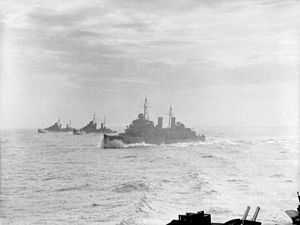HMS Euryalus (42)
 Euryalus at a buoy on completion, June 1941 | |
| Career (UK) | |
|---|---|
| Class and type: | Dido-class light cruiser |
| Name: | HMS Euryalus |
| Builder: | Chatham Dockyard |
| Laid down: | 21 October 1937 |
| Launched: | 6 June 1939 |
| Commissioned: | 30 June 1941 |
| Decommissioned: | 19 September 1954 |
| Fate: | Scrapped, Arrived at Blyth on 18 July 1959 to be scrapped by Hughes Bolckow. |
| General characteristics | |
| Displacement: | 5,600 tons standard 6,850 tons full load |
| Length: | 485 ft (148 m) pp 512 ft (156 m) oa |
| Beam: | 50.5 ft (15.4 m) |
| Draught: | 14 ft (4.3 m) |
| Propulsion: | Parsons geared turbines Four shafts Four Admiralty 3-drum boilers 62,000 shp (46 MW) |
| Speed: | 32.25 knots (60 km/h) |
| Range: | 2,414 km (1,500 miles) at 30 knots 6,824 km (4,240 miles) at 16 knots 1,100 tons fuel oil |
| Complement: | 480 |
| Armament: | Original configuration:
Mid 1943 - Mid 1944 configuration:
Mid 1944 - 1945 configuration:
|
| Armor: | Original configuration:
|
| Notes: | Pennant number 42 |
HMS Euryalus was a Dido-class cruiser of the Royal Navy. She was built at Chatham Dockyard UK), with the keel being laid down on 21 October 1937. She was launched on 6 June 1939, and commissioned 30 June 1941. Euryalus was the last cruiser that Chatham Dockyard built.
History
Mediterranean Service

Second Battle of Sirte

Post War Service
HMS Euryalus was the last original Dido operational in RN, till 1954, mainly on the Sth Atlantic station. It was much the most modernised of the original Didos, having been extensively updated October 1943 – June 1944 at John Browns on the Clyde with new light a/a armament of 20mm, 40mm and 2pdr mounting and a generally new radar suite with 293 radar the standard post war RN target indicator and close range air and surface search, 272 heightfinders and surface warning and new navigation radar. After the end of WW2 HMS Euryalus spent 18 further months in the Pacific Fleet operating from Sydney, Japan and Hong Kong before returning to the UK for a year-long modernisation at Rosyth in 1947-48. By this time the Long range airwarning radar on the HMS Euryalus was the late war 279b/281, the precursor of the post 1945, Type 960. Photos reveal that Euryalus's 5.25 turrets were also modified externally in the same way as Vanguard 's and Royalist 's with the insertion in the turret for operators of a large perplex sighting windows. In the early 1950s a major modernisation was planned for the last two Dido class cruisers in commission, HMS Euryalus and HMS Cleopatra [2] refitting them in a similar pattern to HMS Royalist with the further improvement of new boilers, similar to those of the Daring class. The $4.5 million cost of Royalist's, update to 1950's, carrier fleet picket, standards ruled this out.
Notes
References
- Colledge, J. J.; Warlow, Ben (2006) [1969]. Ships of the Royal Navy: The Complete Record of all Fighting Ships of the Royal Navy (Rev. ed.). London: Chatham Publishing. ISBN 978-1-86176-281-8. OCLC 67375475.
- World War II cruisers
- HMS Euryalus at Uboat.net
External links
| Wikimedia Commons has media related to HMS Euryalus (42). |
| ||||||||||||||||||||||||||||